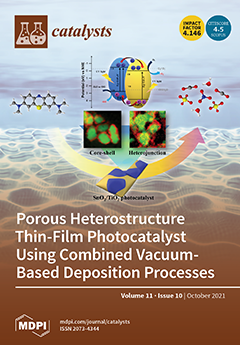The presence of CO
2 in gaseous fuel and feedstock stream of chemical reaction was always considered undesirable. High CO
2 content will decrease quality and heating value of gaseous fuel, such as biohydrogen, which needs a practical approach to remove it. Thus,
[...] Read more.
The presence of CO
2 in gaseous fuel and feedstock stream of chemical reaction was always considered undesirable. High CO
2 content will decrease quality and heating value of gaseous fuel, such as biohydrogen, which needs a practical approach to remove it. Thus, this work aims to introduce the first C
3N
4-metal oxide hybrid for the CO
2 cleaning application from a mixture of CO
2-H
2 gas. The samples were tested for their chemical and physical properties, using field emission scanning electron microscopy (FESEM), transmission electron microscopy (TEM), physical adsorption analysis (BET), fourier-transform infrared (FTIR), x-ray diffraction (XRD), and x-ray photoelectron spectroscopy (XPS). The CO
2 capacity test was carried out by means of a breakthrough test at 1 atm and 25° C using air as a desorption system. Among the samples, amine/metal oxide mass ratio of 2:1 (CNHP500-2(2-1)) showed the best performance of 26.9 wt. % (6.11 mmol/g), with a stable capacity over 6 consecutive cycles. The hybrid sample also showed 3 times better performance than the raw C
3N
4. In addition, it was observed that the hydrothermal C
3N
4 synthesis method demonstrated improved chemical properties and adsorption performance than the conventional dry pyrolysis method. In summary, the performance of hybrid samples depends on the different interactive factors of surface area, pore size and distribution, basicity, concentration of amine precursors, ratio of amines precursors to metal oxide, and framework stability.
Full article





